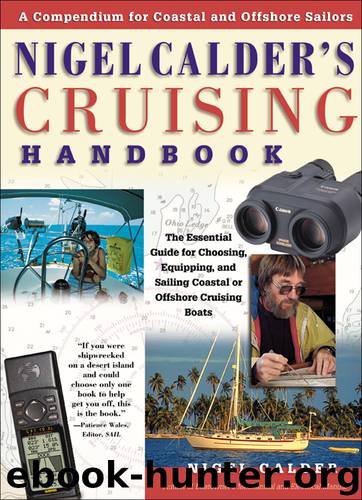Nigel Calder's Cruising Handbook by Nigel Calder

Author:Nigel Calder
Language: eng
Format: epub
Publisher: McGraw-Hill Education
Published: 2001-12-08T16:00:00+00:00
Going to Windward
Assuming a boat is lying head to wind, when a sail is first hoisted with the sheets loose, the sail will simply flap like a flag in the breeze. If the head of the boat is moved away from the wind and the sheet is tightened, the leech will be pulled out of line with the airflow, causing that part of the sail to fill with wind and stop flapping. The forward part of the sail will still be lined up with the wind and will still be flapping (luffing ).
Increasing sheet tension pulls the entire sail out of line with the airflow until luffing ceases. At this point, the sail is in the region of its critical (most efficient or optimum) angle of attack. After this, further tensioning of the sheet drags the leech of the sail around some more, increasing curvature but causing the airflow over the aft part of the sail to separate from the sail and stall out, thereby reducing the sail’s effectiveness (the sail is oversheeted ).
Download
This site does not store any files on its server. We only index and link to content provided by other sites. Please contact the content providers to delete copyright contents if any and email us, we'll remove relevant links or contents immediately.
Breath by James Nestor;(2157)
The River by Peter Heller(2144)
Deep by James Nestor(2083)
Fatal Storm by Rob Mundle(2080)
Sea Survival Handbook by Keith Colwell(2041)
Lonely Planet Australia by Lonely Planet(1972)
Iced In by Chris Turney(1851)
Discover Australia by Lonely Planet(1842)
Lonely Planet Maldives (Travel Guide) by Planet Lonely & Masters Tom(1733)
One Girl One Dream by Dekker Laura(1579)
Looking for a Ship by John McPhee(1572)
Chicken Soup for the Ocean Lover's Soul by Jack Canfield(1549)
Ten Degrees of Reckoning: The True Story of a Family's Love and the Will to Survive by Hester Rumberg(1547)
Lonely Planet Australia (Travel Guide) by Lonely Planet & Lonely Planet(1511)
South with the Sun by Lynne Cox(1462)
The Wave In Pursuit of the Rogues, Freaks and Giants of the Ocean(1428)
Diver Down by Michael Ange(1421)
Marlinspike Sailor's Arts and Crafts by Barbara Merry(1409)
The Golden Rules: 10 Steps to World-Class Excellence in Your Life and Work by Bob Bowman & Charles Butler(1383)
